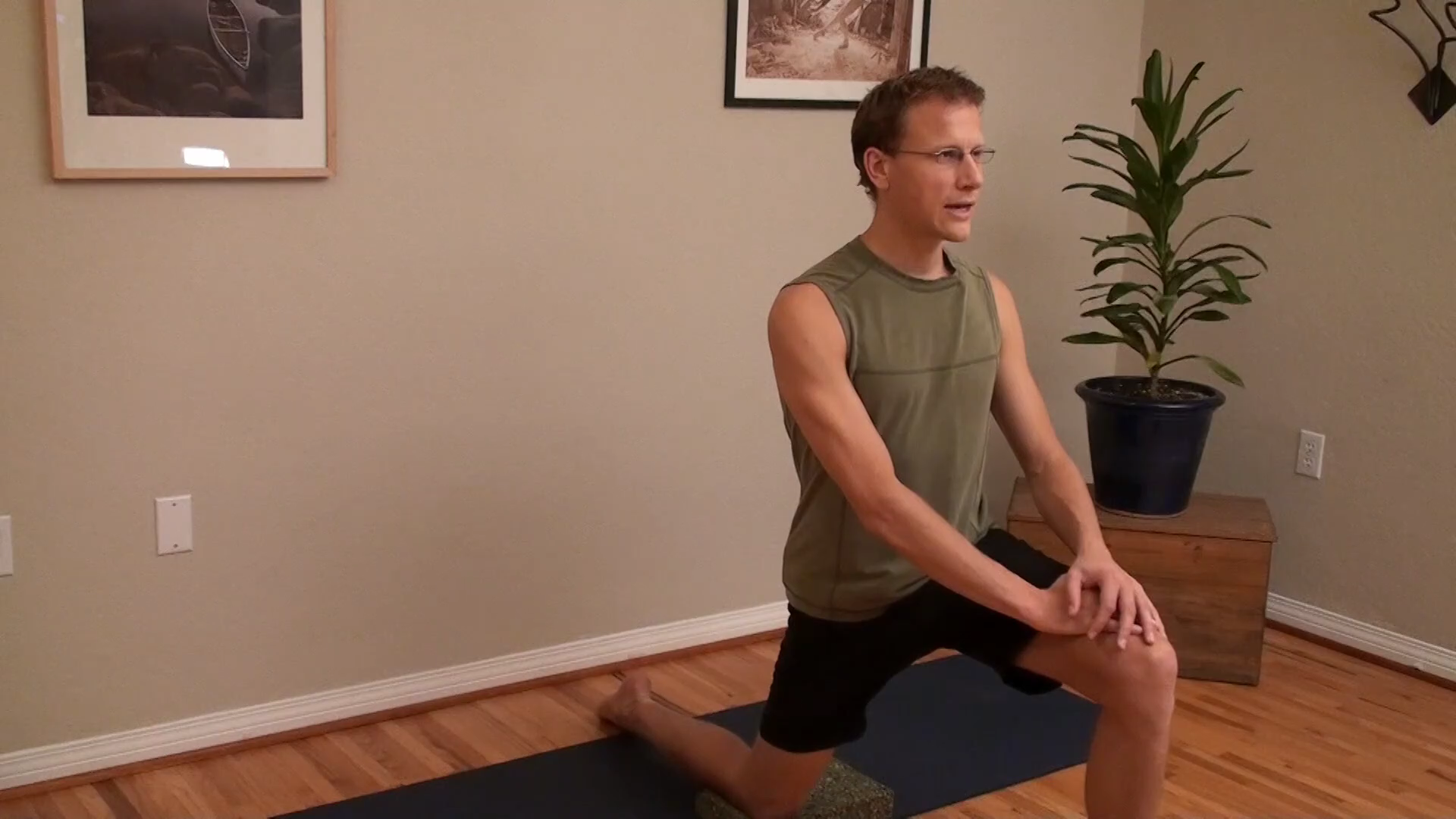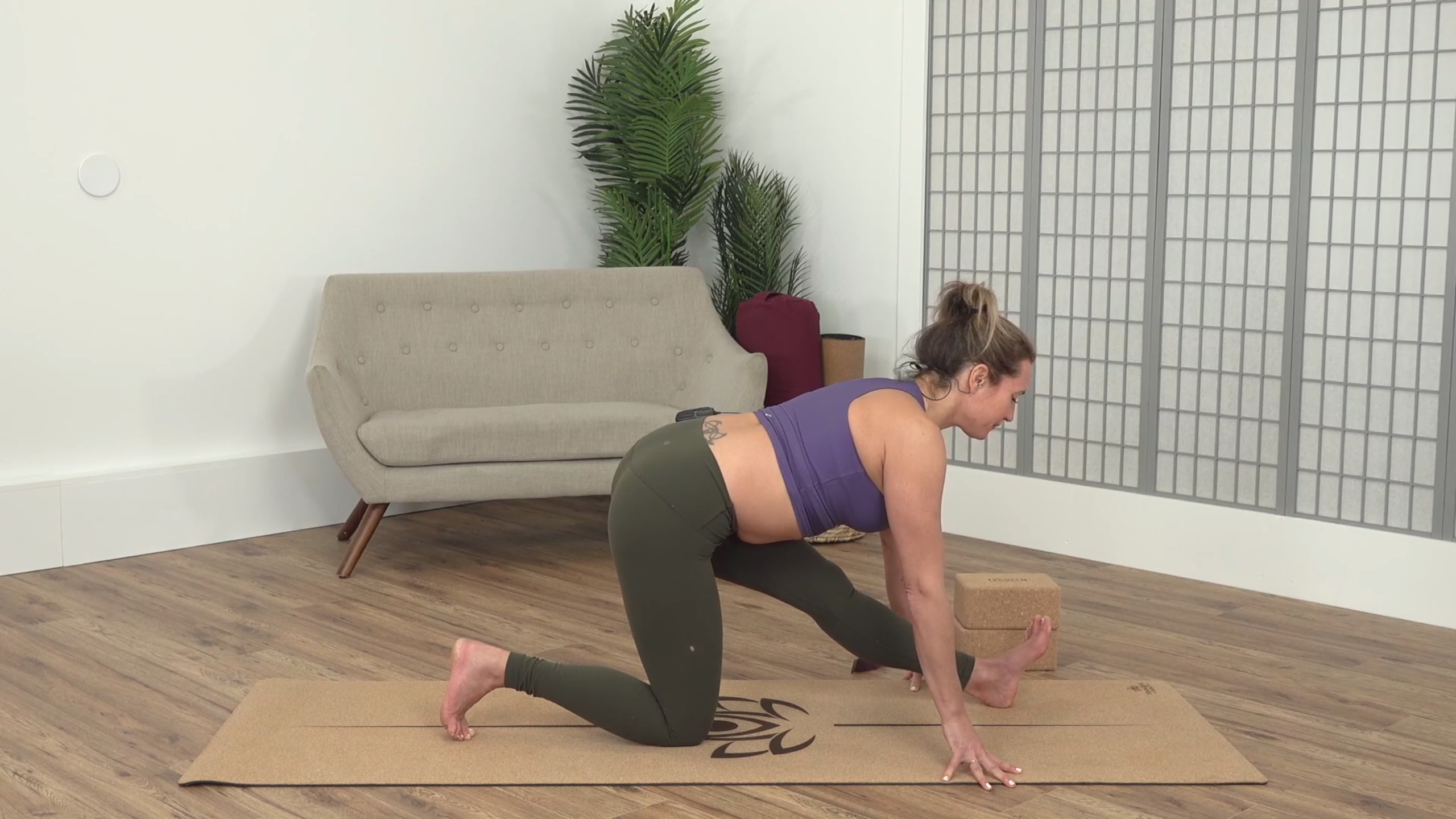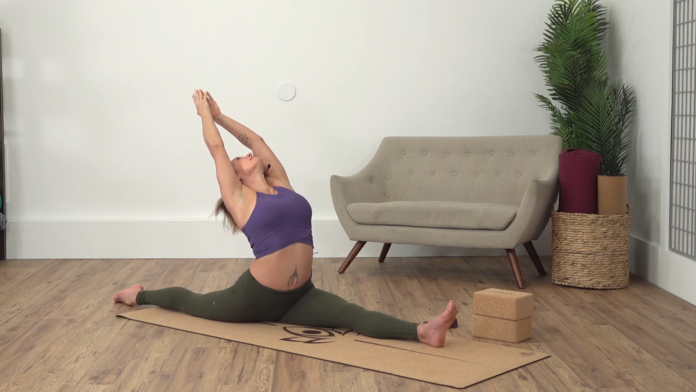Hanumanasana or Monkey Pose is named after the Monkey King, Hanuman, from Hindu mythology. Hanuman is a devoted soul, and some images even include depictions of him opening his heart to show his dear friend Ram and Ram’s wife Sita inside him.
While there are many variations of this story, the takeaway tends to be the same: stories of faith, dedication, and connection to the divine.
Known for his great jumping ability, one of Hanuman’s most famed leaps was from the southern tip of India to Sri Lanka! He performed this feat to rescue his friend’s wife Sita from the demon Ravana.
If you can imagine him leaping from one land mass to the other with one leg thrown forward and the other leg behind, you’ve got the iconic image that led to the naming of this challenging pose—also known as the splits.
Just as this pose takes time and dedication, Hanuman didn’t start life making leaps such as these.
The Origins of Hanuman
Hanuman was born Anjaneya, the son of Vaju, the wind god, and Anjana, a mortal woman. This made Anjaneya a demi-god.
In a popular version of the story, due to his mischievousness, one of the gods (which one it was varies from source to source) dealt Hanuman a fatal blow.
In some versions, the wind god’s sadness and anger were so extreme that the gods returned Anjaneya to life on the condition that he be unable to remember that he was a demi-god.
Removed from his mother, he spent his next years with Sugriva, the monkey king, during which time he also met King (or Prince, depending on the source) Ram.
When the demon Ravana attempted to kidnap Ram’s wife, Sita, it fell to Hanuman to save her. It was then that he made his epic leap to Sri Lanka.
This was a physical leap, but it was also a leap of faith. Hanuman believed in himself, even though the gods had erased any memory of his divinity and, thus, his extraordinary power.
What is more, Hanuman came to symbolize devotion because of the dedication he showed to his friend King Ram.
Because of these two things—through which he ultimately found Sita and, with King Ram’s help, saved her and defeated the demon’s army—hanumanasana echoes the idea that we can do things that might be considered impossible if we set our minds to them, and that we, too, have forgotten our divine roots.
Whether we are afraid of an immense task or just discouraged by the discomfort of a challenge, the story of Hanuman reminds us what we can achieve with faith and dedication.
We can apply the same values of faith and dedication in our practice of hanumanasana. If you’re not a gymnast or a wonder of nature who finds doing the splits naturally easy, the full expression of hanumanasana can take a lot of time to attain. Some body types will be physically unable to ever reach the full expression of this pose (and that’s ok!).
Faithful and dedicated practice, however, will see that you don’t skip the pose or decide it’s not for you. Rather, you can find your way into the pose (or a variation of it) to embody Hanuman’s faith, and enjoy the benefits.
Benefits of Hanumanasana
Hanumanasana is known for its combination of mental and physical benefits.
Physically, it can lead to improvements in strength and flexibility. It’s great for opening up your hips and stretching your hip flexors. It will also give your groin and hamstrings a great stretch.
Hanumanasana can benefit our state of mind if we approach the practice in the spirit of the mythological Hanuman, with a willingness to try, faith in our ability, and dedication to our purpose.
How to Do Hanumanasana
This challenging pose requires care. It opens up your hamstrings AND your quads. Take it slowly and gently, but never push your body into it.
You can expect to feel some deep stretches. As always,back off if you experience any pain.
Warm-Up
Hanumanasana demands flexibility in your legs, particularly your hamstrings and quads. It will also test your hip mobility. So warm up these areas to attempt the pose.
Yoga blocks will help you maintain comfortable alignment as you gradually approach the asana.
- Low-lunge (anjaneyasana) is excellent for stretching your hips. You’ll feel a good stretch in the thigh of your rear leg.

2. Half splits (ardha hanumanasana) is, naturally, a good warm-up for full front splits.

Attaining Hanumanasana
Note that your pelvis doesn’t have to touch the floor to do hanumanasana. Make this an active rather than passive pose, using your legs to support your weight.
Every body is different. Your joints, your ligaments, and your pelvis will be unlike other people’s, so hanumanasana won’t look the same for everyone.
What’s important is your focus on muscular engagement. Rather than sitting on your prop or mat, try to use your leg muscles to sustain your body weight.
- Start in half splits.
- Keep a soft bend in the front knee.
- Stay upright.
- Walk your blocks back under your shoulders.
- Let your legs support you.
- Straighten your torso as you move the back leg back.
- Keep the toes of your rear foot tucked under and pressed into the ground to build your awareness and keep those muscles active, or, if you’re more flexible or feel confident, lie the top of your foot flat against your mat.
- Squeeze your adductors to maintain the lift.
- Maintain your awareness of your back foot and keep the back leg active.
Getting out of the pose:
Use your hands to push against your props or the mat while using your leg muscles, squeezing to push up.
Admitting the complexity of emerging from this pose gracefully, Basha says:
“Be as slow and compassionate as you need to be, as you slowly take your [rear] knee forward, re-bend your [front] knee, and plant the sole of your [front] foot.”
Tips to Improve Your Hanumanasana
- When warming up with half-splits, use blocks to bring the floor up. Place the blocks by your ankles to create a long spine or further back to provide more stability.
- Engage your feet to help keep the pose active and maintain your physical awareness.
- Your legs don’t need to be straight. Focus on keeping your spine long.
- Avoid hyperextension (over-stretching) by concentrating on muscular engagement. Engage your adductors (inner thighs).
- Have you taken your back leg wide? If so, try moving your rear knee medially.
- Your hips don’t need to stay square. It’s normal and even required to become less square as you descend into hanumanasana.
DYWM Classes for Exploring Hanumanasana
Take your leap of faith with excellent classes featuring hanumanasana.
Journey to Splits is a popular class in which Araba takes you through an active hatha sequence that lengthens the hamstrings and builds awareness, balance, and strength.
In Refine and Align: Hanuman, Andrea makes extensive use of yoga blocks, demonstrating how they can support your body and its alignment.
Energizing and playful, Rachel’s Wild Monkeys links hanumanasana with side plank; perfect for cultivating your can-do spirit of self-belief and exploration.
And in Highway to Hanuman, Jonni-Lyn explores hanumanasana, bravery, and devotion through a jivamukti-inspired practice.












 #viral #prenatal #shorts #soniafitnessmoves #acidity #yoga
#viral #prenatal #shorts #soniafitnessmoves #acidity #yoga
